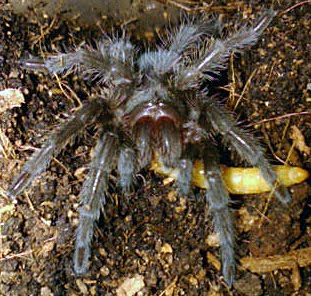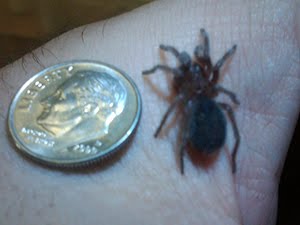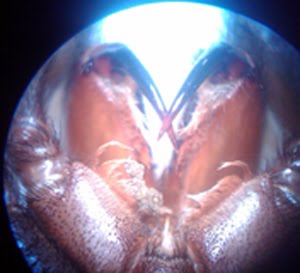My male, 009 molted recently, but is not yet mature. This turned out to be for the best. My female 008, also recently molted, and my female 010 is badly in need of a molt, so she cannot be paired until she molts. I am apprehensive of her impending molt. Since her age is unknown, she is quite large,and her body is quite worn there is the possibility she is very old.
010 is doing well, and has adjusted to her new habitat. She cast off the broken tibia about a week after arriving. I do not get to see her take prey, but the roaches disappear and her abdomen is plump, so she must eat during the night. She drinks from her water dish frequently, I have caught her in the act a few times now. I do not ever see her outside of her hide, whereas the other two adults are frequently out of their hides.
As a matter of fact, 008 almost never goes into her hide. She sits out on the thick silk mat, in the middle of the enclosure, she spun back in July. 009, the male, will venture out when all is quiet, but bolts for his hide at the slightest disturbance.
The substrate in 008, 009, 010's enclosure had become dry near the bottom (sub is 5" deep) and humidity was about 34%. I added about 1.5L of distilled water to each enclosure over a period of two hours to moisten the lower layers and raise humidity slightly. I use a long funnel pushed into the substrate to direct water to the bottom, keeping the surface dry. None of them has shown any interest or attempts to burrow. They have modified their hides and moved substrate around them, but they do not try to burrow. I am curious to see if they would make a burrow if they had no hide available.
 |
| 008 9Aug10 solid 6" now |
 |
| 008 9Aug10 |
 |
| 009 13Aug10 He is much more stunning than the camera shows. He also covered the glass with silk. |








